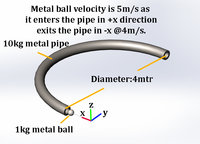Hi,
Not sure which area to post this question...
My last Maths class was 50 years ago, can anyone please help me I have the following question, :
Setup...
1 x length of pipe bent 180 degrees with an inner diameter of 22mm, it's radius is 2mtrs, the mass of this object is 10kg. Total length of pipe (4*3.14/2) = 6.28 mtr.
1 x Metal ball (sphere) with a Diameter of 20mm and a mass of 1kg.
Question:
Assuming there is no gravity.
I introduce the metal ball into the tube at a velocity of 5m/s with a force of 5N (F=ma)
Friction inside the tube, causes the ball to exit the pipe with a velocity of 4m/s.
What is the total reactive force acting on the pipe?
A followup question is what direction (x/y) is this force acting on the pipe. (Assuming the pipe lays x/y direction with the ball introduced into the x direction) What is the linear displacement vector for the tube.
My confusion lays in the centrifugal force (F = m v² / r ) which gives the figure 25/2 = 12.5N.
Many thanks
Tony Cross
Not sure which area to post this question...
My last Maths class was 50 years ago, can anyone please help me I have the following question, :
Setup...
1 x length of pipe bent 180 degrees with an inner diameter of 22mm, it's radius is 2mtrs, the mass of this object is 10kg. Total length of pipe (4*3.14/2) = 6.28 mtr.
1 x Metal ball (sphere) with a Diameter of 20mm and a mass of 1kg.
Question:
Assuming there is no gravity.
I introduce the metal ball into the tube at a velocity of 5m/s with a force of 5N (F=ma)
Friction inside the tube, causes the ball to exit the pipe with a velocity of 4m/s.
What is the total reactive force acting on the pipe?
A followup question is what direction (x/y) is this force acting on the pipe. (Assuming the pipe lays x/y direction with the ball introduced into the x direction) What is the linear displacement vector for the tube.
My confusion lays in the centrifugal force (F = m v² / r ) which gives the figure 25/2 = 12.5N.
Many thanks
Tony Cross
Last edited:

